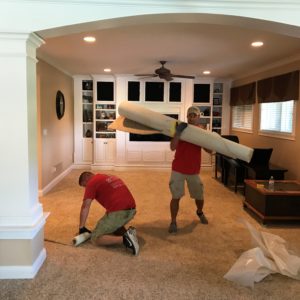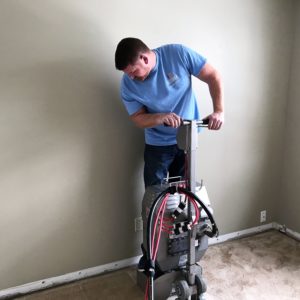Flooded Basement Cleanup Process
A flooded basement can be an overwhelming experience for any homeowner or business owner. The cleanup process can last between 3 to 5 days and there are 6 steps to the process:
- Water Damage Inspection
- Water Removal
- Removals
- Drying Equipment Set up
- Equipment Monitoring
- Final Evaluation.
Water Damage Inspection
A water damage inspection determines the extent of the water damage in the basement. The basement flooring can be visually inspected but at times the water can get carpet and pad wet, without showing on the carpet surface. Our team uses different types of moisture detection devices to find water damage, including non-invasive moisture meters and infrared cameras. Read more about How Restorex Investigates Water Damage.
After the flooring is inspected, the baseboard and the walls need to be inspected for water damage. Typically, the water will get the drywall wet 1 to 2 inches up the wall. If the drywall is wet from the water then more than likely the baseboards will be wet too.
The walls can show wetness up as high 12 inches, when the water was only 2 inches in the basement. If the walls are showing wetness above the baseboards, then we would need to see if the walls are insulated. If the insulation gets wet, then the drywall needs to be removed so we can remove the wet insulation.
Water Removal
The next step in the cleanup process is water removal. The most effective way to clean up a flooded basement is to remove the water with pumps. The initial water is removed using a 2 inch submersible pump or by replacing a sump pump that failed. When most of the water is removed using pumps, we need to use special extractors to remove the remaining water.
We use the best water extractors in the restoration industry. These extraction units can remove water out of the wet carpet and pad. During the extraction process, we will need to move the furniture and contents in the basement. This allows us to run the extractor over all the affected areas in the basement.
Building Materials Removal
After water removal, we will begin removing building materials and contents that will not dry out during the cleanup process. In a flooded basement, this can include baseboards, drywall and insulation. The baseboards most of the time are always removed in order to expose the wet drywall behind them. After the baseboards are removed, we will use a metal pipe to punch holes in the drywall to allow air move into the wall cavities to ensure we dry the entire wall cavity. Watch a video of Restorex punching holes in drywall.
As mention earlier, if the water level rises above the baseboards and the walls are insulated, we will need to remove the drywall, in order to remove the wet insulation. Read more about How to remove drywall affected by water damage?
If there is a bathroom or kitchen in the basement, sometime we will need to remove vanities or cabinets that are affected. If the cabinets are made out of plywood they will dry out most of the time, but if they are built out of particle board they are typically ruined when they get wet.
Water Damage Equipment Set Up
Standard water damage equipment for flood restoration projects are Low Grain Refrigerant (LGR) Dehumidifiers, Electric Heaters, and Air Movers. This equipment provides the necessary energy to remove the water from the affected building materials.
The equipment will use the home’s electricity. At times, the basement’s electric outlets are unable to provide the amount of power needed, in this case we add an electrical distribution box or bring in a professional electrician to get us more power. This can happen in older homes with outdated electrical panels or really large basements that don’t have a lot of dedicated electrical circuits.
The equipment can be very noisy and it will raise the temperature of the basement. During the drying process, the environment will not be one you will want to spend time in. Most of our customers are initially okay with the drying equipment being in their house, but by the end of the process they are very thankful that we are taking it out.
Equipment Monitoring
The water damage equipment needs to run for a minimum of 3 days. In these 3 days, we need to stop by to check on the equipment. Our team will make sure all the equipment is running properly, get temperature and relative humidity readings, and adjust the drying equipment.
These visits will last be between 15 – 30 minutes and they are good times for our customers to ask any questions that they did not ask during the initial steps of the cleanup process.
The readings tell us if the equipment is creating a good drying environment in the basement. If the readings are not where we would like them, we will move the equipment or add more equipment to make the drying conditions better.
Final Water Damage Evaluation
After 3 days we will inspect the basement and determine if the materials have dried to their original moisture content. If everything has dried properly during the mitigation process, we will remove the drying equipment and adjust the furniture and contents back to their original locations. The water damage repairs will come next.
Usually an insurance adjuster will want to come out to the home, to inspect the basement, after the drying is complete.
Unfinished Basement Flood Cleanups
A unfinished basement flood cleanup can cost between 1000 to 2500 dollars. We believe that it doesn’t always make sense for a restoration contractor to be involved for unfinished basement cleanups. Which is why, Restorex will help some customers by giving them free advice on how to complete the cleanup themselves.
If a customer is willing to put in some sweat equity and buy a few pieces of drying equipment from a hardware store, then they can potentially save a lot of money.
Flooded Basement Cleanup Cost
The cost of a flooded basement cleanup can range between 2500 to 5000 dollars for a standard finished basement. These basements are between 800 and 1500 square feet and are finished with drywall, baseboards, carpeting, and other finishes including bathrooms and kitchens. This cost estimate is only for the water mitigation or the water cleanup portion of the restoration process, so water damage repair cost would in addition.
Cleaning up a flooded basement on overtime hours will increase the price by about 1.5 times, which means the cost will be between 3750 to 7500 dollars. It will usually benefit the home owner to wait and have a restoration company complete the cleanup process on normal time hours. Insurance coverage for flooded basements usually have a limit of 10000 – 15000 dollars.
If you have a 1000 square foot basement and you hire a restoration contractor to work after 5 pm or on Saturday or Sunday, then you will lose a lot of your budget cleaning up the water damage on overtime hours. You may run out of money from your insurance coverage to make the water damage repairs and will have to pay extra out of pocket.
Flooded Basement Insurance Coverage
Flooded basement insurance coverage can vary from company to company. Great questions to ask your insurance agent is how much is my deductible and do I have a limit?
An insurance deductible is the amount of money that you will pay out of pocket for the water damage cleanup process. This can range from 500 to 5000 dollars. It is always good to know how much a home owner can expect to pay out of pocket. Your agent should be able to provide you with this information.
Some insurance companies do not include sump pump backup or drain backup as a normal part of their insurance policies. This means that some homeowners need to have these coverage added to their policies as additional writers or additional coverage to their home owners policies.
If you have a finished basement, we believe that you should have a minimum of 10000 dollars of coverage for sump pump backup or drain backup. Talk with your insurance agent to confirm your insurance coverage. If you do not have the coverage, you will want to get the coverage.
Here are some resources we have written to help customers understand water damage insurance.
- Will my insurance company pay for my water damage claim?
- What is an insurance deductible?
- Insurance Agent vs. Insurance Adjuster?
Local Flooded Basement Cleanup Services
Restorex Disaster Restoration helps homeowners who have flooded basements in the local Indianapolis area. If you have a flooded basement in these local areas and need a professional flooded basement restoration company, give us a call (317) 315-5071. We are able to help decided the severity of the water damage and help guide through the water mitigation process and help understand your insurance coverage.


